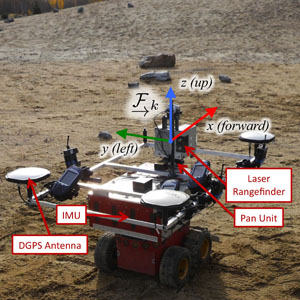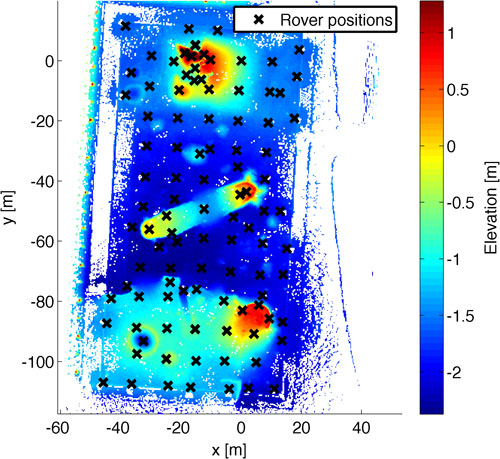

Autonomous Space Robotics Lab
Canadian Planetary Emulation
Terrain 3D Mapping Dataset
p2at_met
[Home] [Overview] [Hardware] [Details] [Downloads] [References]

Photo credit: Équation Groupe Conseil, Inc.
Overview
This dataset consists of 102 laser scans obtained using a modified MobileRobots Pioneer P2AT at the Canadian Space Agency's (CSA) Mars Emulation Terrain (MET), located near Montreal, Quebec, Canada. This dataset was collected for mapping purposes during October 2010.
The CSA MET is an outdoor test facility with workspace dimensions of 120m x 60m. The terrain consists of scattered rocks on sand, along with some large ridge, crater, and outcrop features.
Hardware Setup
 The modified MobileRobots Pioneer P2AT used to gather the dataset carried a number of payloads.
The relevant payloads include a vertically-scanning SICK LMS291-S05 laser rangefinder mounted on a panning unit to produce the 3D scans, an IMU to measure the rover inclination, and a DGPS antenna array to provide ground truth positions and yaw.
The modified MobileRobots Pioneer P2AT used to gather the dataset carried a number of payloads.
The relevant payloads include a vertically-scanning SICK LMS291-S05 laser rangefinder mounted on a panning unit to produce the 3D scans, an IMU to measure the rover inclination, and a DGPS antenna array to provide ground truth positions and yaw.
The laser scanner was configured for a vertical angular resolution of 0.5°, and the scans were constructed by decomposing the 360° sweep into a series of 1/3° steps. Based on the manufacturer's specifications, the SICK LMS291-S05 has a range measurement standard deviation of 0.01m.
As depicted in the figure to the right, the scan reference frame was defined to be the laser rangefinder center, with +x pointing forward, +y to the left, and +z up. The IMU sat inside the rover, and the DGPS antenna array was placed on the rover after each scan to record the ground truth data.
Dataset Details
The 102 scans composing this dataset were obtained with the goal of producing a map of the workspace. As a result, the rover was carefully driven to produce an approximately regular inter-scan spacing of 10m. The following image depicts an overhead view of the terrain, as well as the scan locations.

The ground truth sensor poses were obtained by aggregating the values from an on-board DGPS antenna array, resulting in accurate positions and yaw [1]. The position offset between the DGPS antenna and the laser rangefinder was measured manually. Unfortunately, due to the small baseline of the antenna array, accurate pitch and roll measurements could not be obtained from the antennas. As a result, the IMU measurements were incorporated to fill in the missing elements. Similar to the other datasets, the ground truth reference frame was defined to be the same as the first scan pose.
Downloads
The p2at_met dataset is available at ftp://asrl3.utias.utoronto.ca/3dmap_dataset/p2at_met/.
[Download entire p2at_met dataset (zip) | Compressed size: 125MB, Extracted size: 413MB]
References
[1] Eggert D W, Lorusso A, and Fisher R B. "Estimating 3-D Rigid Body Transformations: A Comparison of Four Major Algorithms." Machine Vision and Applications, 9(5/6):272-290, 1997.